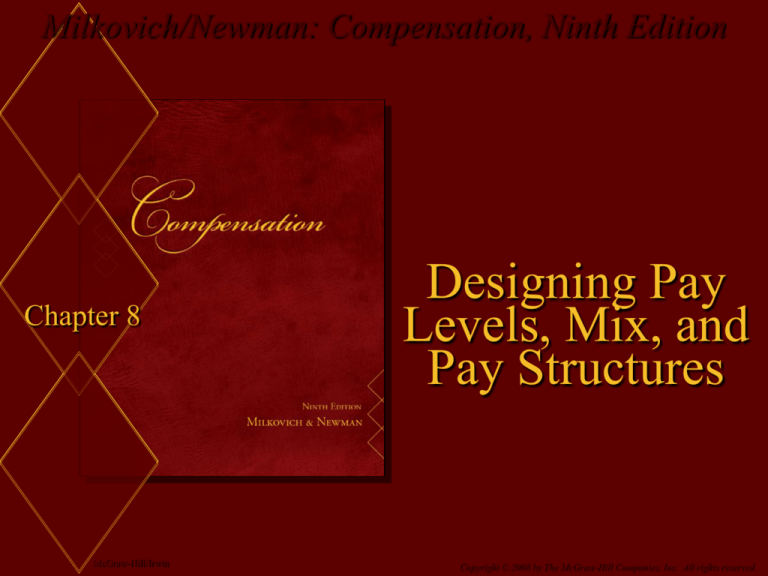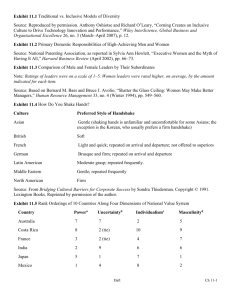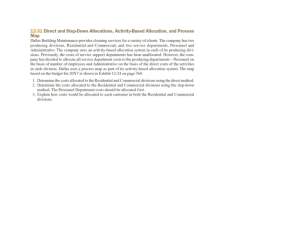
Milkovich/Newman: Compensation, Ninth Edition
Chapter 8
McGraw-Hill/Irwin
Designing Pay
Levels, Mix, and
Pay Structures
Copyright © 2008 by The McGraw-Hill Companies, Inc. All rights reserved.
Exhibit 8.1 Determining Externally
Competitive Pay Levels and Structures
8-2
The Purpose of a Survey
Systematic process of collecting and making
judgments about compensation paid by other Ers
An employer conducts or participates in a survey
for a number of reasons:
– Adjust the pay level in response to changing rates paid
by competitors
– Set the mix of pay forms relative to that paid by
competitors
– Establish or price a pay structure
– Analyze pay-related problems
– Estimate the labor costs of product/service market
competitors
8-3
Select Relevant Market Competitors
Relevant labor market includes employers who
compete
– For same occupations or skills
– For employees in same geographic area
– With same products and services
8-4
Exhibit 8.3: Relevant Labor Markets by
Geographic and Employee Groups
8-5
Exhibit 8.4: Pay Differences by Location
8-6
Design the Survey
Who should be involved?
– Note potential anti-trust issues
1) Use a third party to conduct market surveys
2) Avoid face-to-face encounters with other employers when
sharing data
3) In essential face-to-face encounters, include an independent
third party
4) Make business requirements of the survey data clearly &
publicly known
5) Don’t imply your behavior is contingent on other survey
participant behavior
6) Collect & report aggregate data
How many employers?
– Publicly Available Data
8-7
Exchange of Salary Data May Violate
Sherman Act
14 oil and petrochemical firms accounting for 80-90% of
industry revenue and Ees conducted biannual surveys comparing
pay of nonunion managerial, professional, and technical Ees
Information was compiled, refined, and distributed by thirdparty consultant
In addition, HR staff of participating companies met several
times per year to discuss and exchange salary data
Alleged purpose and effect of data exchange was to artificially
depress salaries by reducing incentive to bid up salaries in order
to attract or retain Ees
Todd v. Exxon Corp. (2nd Circuit, 2001)
8-8
Exhibit 8.5: Free Information on the Web
8-9
Design the Survey (cont.)
Which Jobs to include?
– Benchmark-job approach
Exhibit 8.6: Benchmarks
8-10
Exhibit 8.6: Benchmarks
8-11
Design the Survey (cont.)
What information to collect?
– Organization data
– Total compensation data
8-12
Exhibit 8.7: Possible Survey Data Elements and Rationale
8-13
Exhibit 8.8: Advantages and
Disadvantages of Measures of
Compensation
8-14
Exhibit 8.9: Salary Graphs Using Different Measures of
Compensation
8-15
Interpret Survey Results and Construct a
Market Line
Verify data
– Check accuracy of job matches
– Check for anomalies
Does any one company dominate?
Do all employers show similar patterns?
Outliers?
8-16
Exhibit 8.10 Survey Data
8-17
Exhibit 8.10 Survey Data (con’t)
8-18
Exhibit 8.10 Survey Data (con’t)
8-19
Interpret Survey Results and Construct a
Market Line (cont.)
Statistical analysis
– Frequency distribution
– Measures of central tendency
Mode
Mean
Median
Weighted mean
– Measures of variation
Standard deviation
Quartiles and percentiles
8-20
Interpret Survey Results and Construct a
Market Line (cont.)
Update the survey data
– Aging or trending : Pay data is updated to forecast
the competitive rates for the future date when the
pay decisions will be implemented
8-21
Exhibit 8.13 Choices for Updating Survey Data Reflect
Pay Policy
8-22
Construct a Market Pay Line
A market line links a company's benchmark jobs
on the horizontal axis with market rates paid by
competitors on the vertical axis. It summarizes
the distribution of going rates paid by
competitors in the market
Approaches to constructing a market pay line
– Free hand approach
– Regression Analysis
8-23
Exhibit 8.14: From Regression
Results to a Market Line
How can you get
a negative salary???
8-24
Exhibit 8.15: Understanding Regression
8-25
Combine Internal Structure and External
Market Rates
Two parts of the total pay model have merged
– Internally aligned structure - Horizontal axis
– External competitive data - Vertical axis
Two aspects of pay structure
– Pay-policy line
– Pay ranges
8-26
Exhibit 8.16: Develop Pay Grades
8-27
From Policy to Practice: The Pay Policy
Line
Policy line as percent of market line
– Specify a percent above or below market line an
employer intends to match
– Other options
Lead for some job families and lag for others
8-28
From Policy to Practice: Grades and
Ranges
Why bother with grades and ranges?
– Offer flexibility to deal with pressures from external
markets and differences among firms
A pay range exists whenever two or more rates are
paid to employees in the same job
– Recognize individual performance differences with pay
– Meet employees' expectations that their pay will increase
over time, even in the same job
– Encourage employees to remain with the organization
8-29
From Policy to Practice: Grades and
Ranges (cont.)
Develop grades
– Grades enhance an organization's ability to move
people among jobs with no change in pay
– Each grade will have its own pay range
– All the jobs within a single grade will have the same
pay range
8-30
From Policy to Practice: Grades and
Ranges (cont.)
Establish range midpoints, minimums, and
maximums
– What size should the range be?
Size of range based on judgment about how ranges
support
– Career paths
– Promotions
8-31
Exhibit 8.17: Range Midpoint,
Minimum, and Maximum
8-32
From Policy to Practice: Grades and
Ranges (cont.)
Typical range spread
Top-level management positions – 30 to 60%
above and below midpoint
Midlevel professional and managerial positions –
15 to 30% above and below midpoint
Office and production positions – 5 to 15% above
and below midpoint
8-33
Exhibit 8.18: Range Overlap
8-34
From Policy to Practice:
Broad Banding
Involves collapsing
salary grades into a few
broad bands, each with a sizable range
– One minimum and one maximum
– Range midpoint often not used
8-35
From Policy to Practice:
Broad Banding (cont.)
Purposes
– Provide flexibility to define job responsibilities more
broadly
– Foster cross-functional growth and development
– Ease mergers and acquisitions
8-36
Exhibit 8.19: From Grades to Bands
8-37
Exhibit 8.20: Contrasts Between
Ranges and Bands
8-38
Market Pricing
Market pricing: pay strategies that emphasize
external competitiveness and deemphasize
internal alignment
– Sets pay structures almost exclusively on external
market rates
Objective
– Is to base most of the internal pay structure on
external rates, breaking down the boundaries
between the internal organization and the external
market forces
8-39
Market Pricing (cont.)
Issues
– Validity of market data
– Use of competitors’ pay decisions as primary
determinant of pay structure
– Lack of value added via internal alignment
– Difficult-to-imitate aspects of pay structure are
deemphasized
– Fairness
8-40






